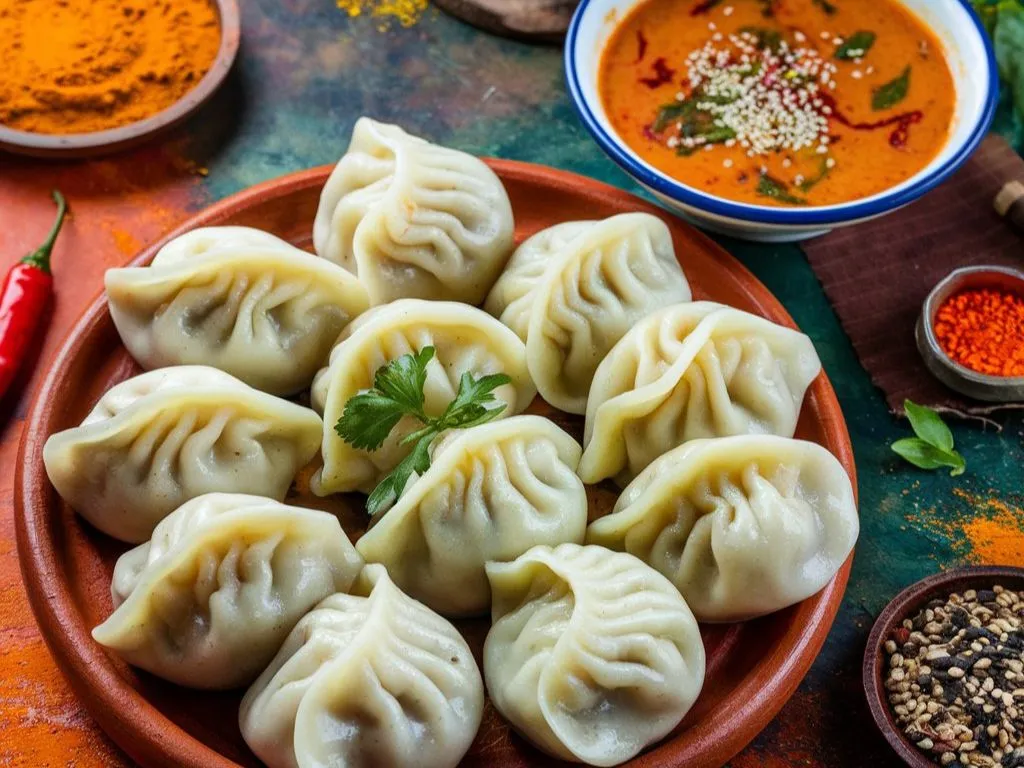In Nepalese cuisine, two popular names you’ll often hear are jhol and momo. While momo refers to the famous dumplings loved across Nepal, jhol is a flavorful sauce often served alongside it. But what exactly distinguishes these two? This article explores the key differences between jhol and momo, along with how these components come together in traditional Nepalese meals.
What is Momo?
Momo is a type of dumpling commonly found in Nepal, Tibet, and parts of India. These delicious dumplings are typically:
- Filled with a variety of ingredients like vegetables or minced meat.
- Steamed or fried, depending on personal preference.
- Shaped into either round or crescent-like forms.
Momos are often served with dipping sauces, the most common being jhol, which we’ll delve into next. You can find more about the history of momo and its cultural significance in this resource.
What is Jhol?
Unlike momo, jhol refers to a flavorful, thin sauce or broth typically served with dumplings. The word “jhol” in Nepali translates to liquid, and it’s a key element in many Nepalese dishes. The core ingredients of jhol often include:
- Roasted sesame seeds for a nutty richness.
- Tomatoes to provide a tangy, flavorful base.
- Peanuts to thicken the sauce and add a slight sweetness.
- A blend of spices like cumin, turmeric, and chili powder to give it heat.
In Nepal, jhol momo is a popular dish where dumplings are drenched in this delicious sauce. Learn more about how jhol enhances Nepalese food here.
Origins of Momo vs. Jhol
While momo originates from Tibet, it was introduced to Nepal through cultural exchange, eventually becoming one of the country’s most iconic dishes. Initially enjoyed by monks and travelers, it has since become a street food favorite.
On the other hand, jhol is deeply rooted in Nepalese culinary tradition. The sauce’s spicy, tangy, and nutty characteristics reflect the country’s rich use of local ingredients like sesame seeds and chili powder.
Key Differences Between Jhol and Momo
1. Texture and Composition
- Momo: Soft and chewy dumplings filled with ingredients like meat or vegetables.
- Jhol: A thin, flavorful broth that is smooth in texture and complements the dumplings.
2. Purpose
- Momo is the main dish and can be enjoyed on its own or with sauces.
- Jhol acts as an accompaniment, enhancing the flavor of momos with its bold, spicy notes.
3. Ingredients
- Momo is made from flour dough with a range of fillings like chicken or vegetarian ingredients.
- Jhol includes spices, tomatoes, sesame seeds, and peanuts, with a thinner, liquid-like consistency.
How Jhol Complements Momo
When served together, jhol adds a spicy, tangy kick to the relatively mild flavor of momos. The dumplings soak up the liquid, providing a burst of flavor with each bite. This combination, known as jhol momo, is beloved in Nepal for its rich flavors and unique texture.
Cooking Methods for Momo and Jhol
Momo
Momo is usually either steamed or fried. Steamed momos are soft and chewy, while fried momos have a crispy outer layer.
Jhol
Jhol is cooked by roasting key ingredients like sesame seeds and peanuts, blending them into a paste, and simmering with spices and tomatoes to create a smooth, tangy sauce.
Health Benefits of Momo and Jhol
Both dishes offer several health benefits:
- Momos: Rich in protein and carbohydrates, especially if filled with meat. Vegetarian versions provide fiber from the vegetables.
- Jhol: Packed with antioxidants from tomatoes and healthy fats from sesame seeds and peanuts, making it a nutritious sauce.
Popular Variations of Momo and Jhol
- Spicy Jhol: More chili powder or fresh chilies can be added to give the sauce extra heat.
- Paneer Momo: Vegetarian momos filled with paneer are a popular variation, especially in India.
FAQs: Jhol and Momo
- What is the difference between jhol and momo?
Jhol is a sauce or broth, while momo refers to the dumplings. They are often served together, but they are two distinct components. - Can you eat momo without jhol?
Yes, momo can be served with other dipping sauces like tomato chutney or even enjoyed on its own. - Is jhol always spicy?
Not always. While jhol typically has some heat, the level of spiciness can be adjusted to taste. - What are the main ingredients in jhol?
The main ingredients are sesame seeds, tomatoes, peanuts, and various spices like cumin and turmeric. - Is jhol momo healthy?
Yes, especially if the momos are steamed and the jhol is made with nutritious ingredients like sesame and tomatoes.
By understanding the differences between jhol and momo, you can appreciate how these two staples of Nepalese cuisine complement each other. Whether you prefer your momos steamed or fried, pairing them with a flavorful jhol sauce is a must-try experience.
